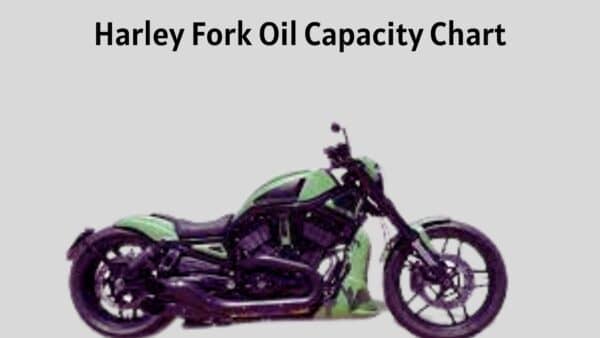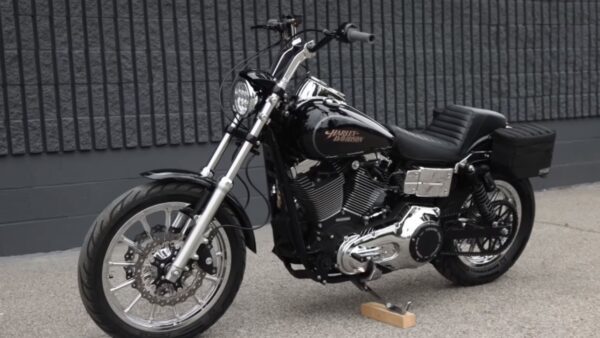
If you are wondering about the fork oil capacity chart, don’t worry because today, in this guide article, I will show and explain the Fork Oil capacity chart.
Let’s dive into:
Importance of Harley fork oil capacity chart
The Harley-fork oil capacity chart is an essential reference tool for Harley-Davidson motorcycle owners and mechanics.
Here are some critical factors of the fork oil chart:
Accurate Measurement:
The chart provides specific oil capacities for different Harley models and years. These measurements ensure the forks perform as intended.
Safety:
Overfilling or underfilling the forks can affect the motorcycle’s handling. Riding a bike with incorrect fork oil levels might lead to unstable maneuvers, especially at high speeds or during sharp turns.
Extend Fork Lifespan:
Proper oil levels and the correct oil type ensure that internal fork components, such as seals and bushings, remain lubricated. This reduces wear and tear, prolonging the lifespan of the forks.
Optimal Performance:
The correct amount of fork oil is crucial for achieving the desired damping effect. Whether you’re looking for a smoother ride or stiffer suspension for aggressive riding, the right oil level is paramount.
Cost Efficiency:
Save yourself from costly repairs or replacements by maintaining the proper fork oil capacity.
Harley fork oil capacity chart
| Model | Year | Wet (Oz.) | Dry (Oz.) |
| Sportster | Till 1972 | 5.5 | 6.5 |
| Sportster | 1972-83 | 5.0 | 6.0 |
| Sportster | 1984-87 | 5.4 | 6.5 |
| Sportster | 1988-2003 | 9.0 | 10.2 |
| Sportster | 2004-08 | 10.5 | 11.6 |
| Sportster XL 883 Hugger | Till 1991 | 9.0 | 10.2 |
| Sportster XL 883 Hugger | 1992-99 | 10.7 | 12.1 |
| FL/FLH | 1948-77 | 6.5 | 7.0 |
| FL/FLH | 1977-84 | 7.75 | 8.5 |
| FLT | 1980-97 | 7.75 | 8.5 |
| FLT | 1998-2001 | 8.7 | 9.7 |
| FLHR | 2002-09 | 10.1 | 11.1 |
| FX/FXE | 1972 | 5.5 | 6.5 |
| FX/FXE | 1973-83 | 5.0 | 6.0 |
| FXR/FXRS | 1985-86 | 6.0 | 7.0 |
| FXR/FXRS | 1991-94 | 9.0 | 10.2 |
| Dyna/Low Rider | 1991-2005 | 9.2 | 10.2 |
| Dyna Wide Glide | 1991-2005 | 10.2 | 11.2 |
| FXWG/FXST | 1980-84 | 9.0 | 10.2 |
| FXWG/FXST | 1985-2006 | 10.2 | 11.2 |
| FLST | 1986-2006 | 11.5 | 12.5 |
| FLST | 2007-09 | 12.4 | 13.4 |
| FXST | 2007-09 | 11.5 | 12.5 |
| FXSTD | 2007 | 10.5 | 11.6 |
Explanatory ideas of chart
The chart mentioned above has two types of measurements, and you may need the different quantities of the fork during the wet and dry conditions.
Generally, the wet refers to the full durian of the oil out of the plug, and you need to refill it.
And dry refers to taking the fork to bits and cleaning them dry from inside to the outside, and you can see that the dry divisions require 0.5 to 1.0 oz, which is more than the wet forks.
The relation between the fork size and the capacity of the oil is not linear; that’s why considering the fork oil capacity is more crucial.
Tips for changing Harley fork oil
These are some simple tips for changing the Harley fork oil.
Safety First:
Before starting, ensure the bike is stable. Use a proper bike stand or lift to secure the motorcycle. It provides it won’t tip over during the process.
Gather Necessary Tools:
As with any task, having the right tools is crucial. For this job, you’ll need a wrench, a drain pan, new fork oil, a measuring unit, and a funnel.
Drain the Old Oil:
Remove the drain plug at the fork leg’s bottom using a wrench. Allow all the old oil to drain into the pan.
Remember, patience is critical to remove all the old oil to avoid mixing old and new oil.
Refill with New Oil:
It’s time to refill after ensuring all the old oil is out. Pour the specified amount of new fork oil using a measuring unit into the fork.
Check the Oil Level:
Once you’ve added the oil, checking the level is essential. Most Harley models have a specific oil level that ensures optimum performance. Stick to the manufacturer’s guidelines to get the story just right.
Seal Everything Up:
After refilling, it’s time to put the drain plug back. Ensure it’s tightly secured to prevent any leaks.
Test Ride:
After everything is sealed up, take your Harley for a test ride. It will help you determine if the suspension feels right and if any issues need addressing.
What to look for in a capacity chart for the Harley forks?
Here are a few things you should keep in mind:
- The chart is very easy to readable and understandable, and the excellent quality of the fork oil chart should not have any confusing symbols or jargon
- It may provide accurate data, and it should base on data from a reputable source such as the Harley
- It should be trendy or up-to-date and include the most recent information available.
How often should you change the fork oil?
Changing the frequency of fork oil does not maintain the linear line. So the experts and pros preferred that you replace your bike’s fork oil after every 3000 to 5000 miles.
Changing the fork oil also depends on how you ride the bike and the terrain. How you ride a motorcycle includes continuous suspension compressing and rebounding.
It produces extreme heat, and the fork absorbs the heat and helps the rebounding and compressing process without any performance drop.
FAQ
How much fork oil does my Harley take?
The amount of fork oil a Harley requires varies by model and year.
Always consult your owner’s manual or Harley-Davidson’s official specifications for the precise quantity your motorcycle needs.
Generally, the Harley needs 330ml fork oil to work in excellent condition.
How much oil do I put in my forks?
The amount of oil in motorcycle forks varies by make, model, and year. Factors like fork design and desired damping also influence the quantity.
Consult your motorcycle’s owner’s manual or the manufacturer’s specifications for accurate measurements.
Overfilling or underfilling can impact performance and safety. Always ensure correct levels for optimal suspension function.
What weight fork oil should I use for a Harley?
The appropriate fork oil weight for a Harley-Davidson motorcycle depends on the model, year, and desired handling characteristics.
The right oil weight ensures optimal damping and improves overall suspension performance, providing a smoother ride and better handling.
Harley owners commonly use 10W or 20W fork oil, but it’s essential to consult the owner’s manual or Harley-Davidson’s official recommendations for your specific bike.
Is thicker fork oil better?
Thicker fork oil increases damping resistance, making the suspension feel stiffer. At the same time, it might be better for heavier loads or aggressive riding.
It can compromise comfort. Proper viscosity depends on riding style and bike specifications.
Wrapping Up
This article helps you find the correct fork oil and the quantity of oil for your Harley bike.
Changing the fork oil of your Harley is one of the most crucial parts of maintaining your bike. Regular changing of fork oil ensures that they are working in good condition and good condition.
If you suspect that your bike’s fork oil is leaking or needs to be changed, then it would be best to take it to the expert mechanic. It will save a lot of tension and time.
You may also love to read this:
Harley Davidson Engine Size Chart
Harley Davidson Battery Size Chart
Harley Davidson Belt Size Chart
Harley Davidson Tire Pressure Chart

Ahtsham Younas is a passionate blogger and content writer. He loves to ride motorcycles and learn the mechanical process behind the motorcycles.
He has been writing articles in the motorcycle industry since 2019 and has learned many things about motorbike niches.


